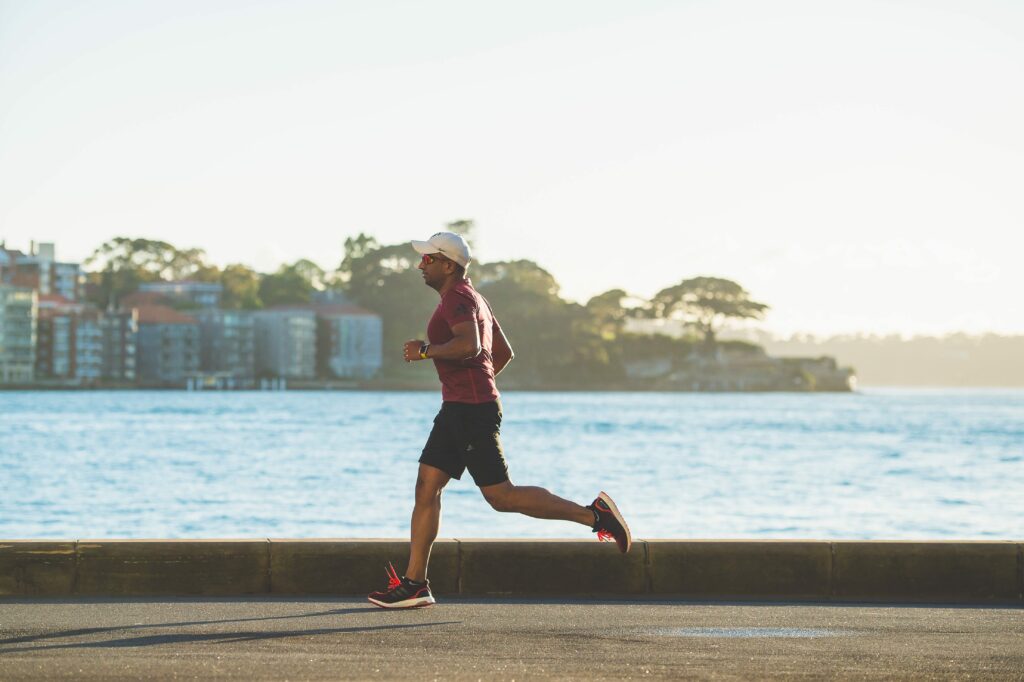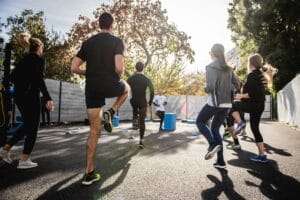Running is an excellent activity that you can do for your body. It is a multi-layered and complex movement that engages your whole body. Running gives you a cardio-vascular workout like no other sport, and it also has great benefits for your mental health.
If you are on the overweight side, running can be intimidating. People that have been running for a long time can look like professionals. You’ll see people out on the trails with lots of expensive gear like watches and other gadgets. You’ll also see people running much faster and further than you.
These types of people can make you feel awkward about getting involved in the sport. Don’t let that happen! Every runner started running at some point. They all remember what it was like when they were just starting out, and you’ll be pleased with how supportive the running community can be.
We also understand that running can be even more daunting for people of larger stature. Being overweight can cause more stress on your ankles and knees, and it can make your heart beat harder once you get into the cardio training zone. Many larger people automatically assume that running is something that they simply cannot do.
They think that they will never be able to run until they lose some weight. That’s why we’ve put together this running plan for overweight beginners. We want you to feel confident that you can start running and use it as a tool to help you get healthy.
Just remember – anyone who runs is a runner! You don’t need to feel intimidated about getting started. It’s your body, and you get to use it for any activity you want to do.
Start with Slow and Short Runs
The most important rule for a beginner is to start off slowly. This is especially true if you’re carrying some extra weight. Your body can’t just knock out a 5k without working up to that distance and speed. You need to set a realistic goal for your first several runs, with the goal of just getting out there and running.
Consider a run-walk approach for your first few runs. This means that you run for one minute, and then you walk for one minute. You can alternate through that as many times as needed to get to a mile. Your first run shouldn’t be any longer than a mile, and if you need to use a walk-run strategy to get there, go for it!
Only after you can jog one full mile without stopping should you consider increasing your distance any further than that. You can start doing two or three mile runs, but every time you increase the distance, go back to utilizing the run-walk strategy until you have built up a base that will allow you to get there and back.
The concept of building up a base is something to keep in mind as well. You want to be able to comfortably run a few miles, and you need to take your time to get there. Once you’ve built up that base you can consider getting more involved with faster paces or further distances.
Focus on Form
Experienced runners will tell you that trying to change your form after it becomes a habit can be difficult to do. Since you’re starting out at the beginning, you have the advantage of not having any bad habits to break! Pay attention to the mechanics of your stride and make sure you are training yourself to automatically run with a correct form.
There are dozens of instructional videos that show you how to run properly. Our advice is to research what a proper running stride looks like and try to mimic that on your first few runs. Instead of just going out and putting one foot in front of the other, try to run efficiently as that will keep you on the road longer.
Running form includes the posture of your upper body, the tilt of your hips, the firing of your glutes and core, and many other things that you probably didn’t realize were all a part of running.
Pace Doesn’t Matter
In the first several months of your running life, there is no need to pay any attention to the pace you are running. All you want to do at the beginning is build up the ability to jog or run a few miles continuously, without having to switch to walking or stopping completely. Once you master that, you can worry about pace.
People who are training for big races will usually have pace goals. For example, if someone wants to run a marathon in less than four hours, they will need to run each mile at a pace of just over nine minutes per mile. That’s why you’ll see people looking at their watches while running and constantly worrying about whether they are training at the pace that will get them to their goal. Their goals are not your goals! Don’t fall for in the pressure to calculate your pace and train to any pace, until you are ready to do so.
It can be very hard to get caught up in the numbers of running. Many runners use fancy and expensive watches to track their mileage and their pace. These tools are useful, but in the beginning stage there is no need to track these statistics. Running to a specific pace puts a lot of pressure on yourself that you don’t need when you are just starting out.
Stretch!
If you want to keep running, or if you want to recover from your runs faster, always stretch after every run. Stretching doesn’t just include a few seconds of pulling your foot up behind you to stretch your quadricep. A proper stretching routine should take 15 to 20 seconds and should work each of the different muscle groups in your legs and core.
Yoga can be a great complement to running, and often includes stretches that specifically work the muscles that get the most use during a run. Positions like downward-facing dog and pigeon are great for your legs. If you are comfortable doing yoga at home, search online for some videos that are specifically called Yoga for Runners, as these videos will focus on the areas of your body that need the most attention.
Strength Training
Another important aspect of a beginning training plan is to be sure to include strength training. This means lifting weights or doing bodyweight resistance exercises. These are critically important for larger-sized runners because you need to be able to strengthen the muscles in your legs in order for them to handle the runs that you are going to put them through.
Some examples of strength training are:
– Squats: Be sure to do a full range of motion in your squat, sinking your glutes as far down to the ground as they can go. This motion is the most important part, the weight you use to do it can be very light. Or you can do it with just your body weight.
– Calf Raises: Building up strong calf muscles is very important, especially if you are planning to run on any uneven surfaces. These can be done on a stair, where you put your toes one stair up and let your heels sink down as low as they will go. Stand up to your tiptoes, and then slowly lower yourself back down.
– Core Exercises: Running may happen in the legs, but the real strength comes from your core. Having a solid abdomen will help you keep your posture throughout your runs and will allow you to stay running longer.
Don’t be afraid if the strength training combined with running causes some muscle soreness. Just make sure you are not overdoing either, and that you are taking plenty of time to rest and recover in between workouts.
Cross-Training
If you want to get started in running, it is also important to incorporate cross-training into your regimen. Cross-training is any cardiovascular workout that works your legs, but is not running. The most popular format used for cross-training is the elliptical machine.
The elliptical machine is a great tool for getting your heart rate going, while not putting your knees and ankles under the stress that come from running.
Cycling is another great form of cross-training. Whether you are outside on a bike or inside on an exercise machine, the motion of cycling does great things for your legs, without the repetitive impact of the foot strike that happens while running. Swimming can also be a form of cross-training, but with its focus on the upper body, it is important that you choose swim strokes that will allow you to kick with your legs more than pull with your arms.
Walking can even be a form of cross-training, provided you are staying consistent with your pace and not letting yourself get carried away into a jog. We only recommend working in walking as your cross-training sessions if you are not experiencing any muscle soreness in your legs.
Set Realistic Goals
Having a realistic goal is all that matters for an overweight runner, or a beginner runner. You aren’t going to go to the Olympics, and you are not going to win the Boston Marathon! Those are not realistic goals for anyone except the most elite runners that have been running competitively since they were kids.
Realistic goals for beginner runners should focus on things that will help keep you motivated. Ask yourself what those things are. Do you want to lose weight and keep it off? If so, running is a great activity for you. The running goals you can set for yourself to meet that goal are many: You can set a goal to run three times a week, you can set a goal to run one additional mile every week for 10 weeks. Choose a goal that will keep you coming back for more runs, while you consistently increase the difficulty to keep it challenging.
If you have distance goals, like you want to run a marathon, always start with something smaller than that. Try finishing a 5k before going for the big show!
Conclusion
If you are running too fast or too far, you may need to slow down and shorten your runs. If you are sore all the time, you may need to run fewer days each week. Some muscle soreness is normal, but if you find yourself limping around your home after a run, it may be time to dial it back.
Running is a tool that you can use to keep your body healthy. It is also a tool for improving your mental health. If you lose the joy of running, you’ll lose the benefits that come from running. So, keep it fun and keep it healthy! Good luck and happy running!































